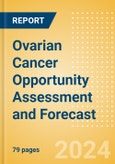Ovarian Cancer is one of the most lethal gynecological cancers worldwide. Despite being a rare cancer, ovarian cancer is a blockbuster market and is expected to grow from sales of $3.3 billion in 2022 to $4.1 billion in 2032 at a compound annual growth rate (CAGR) of 2.0%. Ovarian cancer patients generally respond well to platinum-based chemotherapy and achieve complete remission in the initial setting. However, the risk of recurrence for patients with residual disease is high. Additionally, the rapid emergence of chemotherapy resistance is observed. Currently, the standard treatment for platinum-resistant patients is sequential non-platinum treatment with either monotherapy or combination treatment with targeted therapy (bevacizumab) or cytotoxic agents (taxanes, gemcitabine, pegylated liposomal doxorubicin, or topotecan).There are several unmet needs in Ovarian Cancer that call for improved front-line treatment options and alternative options for platinum-resistant patients for extending overall survival in patients.
Major drivers of growth in the Ovarian Cancer market across the 7MM over the forecast period include the following:
- The sales of ImmunoGen’s Elahere represent the most impactful driver of growth for the ovarian cancer market. Elahere is anticipated to launch in the 5EU and Japan during the forecast period.
- Combinations of PARP inhibitors, VEGF inhibitors, and ICIs are expected to launch in the 7MM during the forecast period.
- New drug launches for novel therapies will take considerable market share from generic chemotherapies.
- PARP inhibitors are established in the front-line maintenance setting with high treatment rates and are expected to retain their market share in the first-line setting.
- chemotherapies.
Major barriers to growth in the Ovarian Cancer market across the 7MM over the forecast period include the following:
- High costs and issues with reimbursement associated with both front-line treatments and prospective novel therapies may reduce uptake and off-label usage.
- Voluntary withdrawals and generic erosion upon the patent expiries of the PARP inhibitors will temper sales growth during the forecast period in the ovarian cancer market.
- This report covers the 7MM (US, France, Germany, Italy, Spain, UK, and Japan) and includes an assessment of the disease epidemiology and 10-year patient-based forecast (PBF) across the 7MM for marketed and late-stage pipeline therapies, with a launch date assessment by market for Ovarian Cancer.
- These sales forecasts leverage data on pharmaceutical sales and drug availability from the publisher's World Markets Healthcare (WMH) and POLI Price Intelligence databases.
- Ovarian Cancer is one of the most lethal gynecological cancers worldwide. Despite being a rare cancer, ovarian cancer is a blockbuster market and is expected to grow from sales of $3.3 billion in 2022 to $4.1 billion in 2032 at a compound annual growth rate (CAGR) of 2.0%.
Key Highlights
- Report deliverables include a Pdf report and Excel-based forecast model
- Forecasts includes the 7MM
- Forecasts covers from 2022-2032
- The publisher valued the Ovarian Cancer market in the 7MM at $3.3 billion and expects the market to increase to $4.1 billion by 2032
- ImmunoGen, AstraZeneca, Merck, and GSK are expected to take market-leading position in 2032
- A high level of unmet need will remain for most Ovarian Cancer patient populations during the forecast period
- The Ovarian Cancer late-stage R&D pipeline is widely varied with several novel therapeutic classes
Scope
- Overview of Ovarian Cancer, including epidemiology, symptoms, diagnosis, and disease management.
- Annualized Ovarian Cancer therapeutics market revenue, cost of therapy per patient, and treatment usage patterns forecast from 2022 to 2032.
- Key topics covered include strategic competitor assessment, market characterization, unmet needs, clinical trial mapping, and implications of these factors for the Ovarian Cancer therapeutics market.
- Pipeline analysis: comprehensive data assessing emerging trends and mechanisms of action under development for Ovarian Cancer treatment. The most promising candidates in Phase III and Phase IIb development are profiled.
- Analysis of the current and future market competition in the global Ovarian Cancer therapeutics market. Insightful review of the key industry drivers, restraints and challenges. Each trend is independently researched to provide qualitative analysis of its implications
Reasons to Buy
- Develop and design your in-licensing and out-licensing strategies through a review of pipeline products and technologies, and by identifying the companies with the most robust pipeline.
- Develop business strategies by understanding the trends shaping and driving the global Ovarian Cancer therapeutics market.
- Drive revenues by understanding the key trends, innovative products and technologies, market segments, and companies likely to impact the global Ovarian Cancer therapeutics market in the future.
- Formulate effective sales and marketing strategies by understanding the competitive landscape and by analyzing the performance of various competitors.
- Identify emerging players with potentially strong product portfolios and create effective counter-strategies to gain a competitive advantage.
- Organize your sales and marketing efforts by identifying the market categories and segments that present maximum opportunities for consolidations, investments and strategic partnerships








